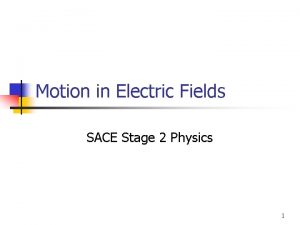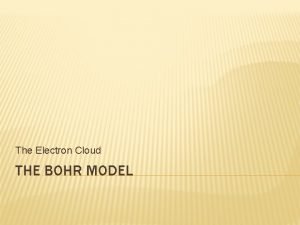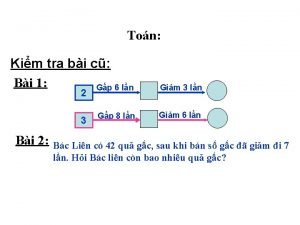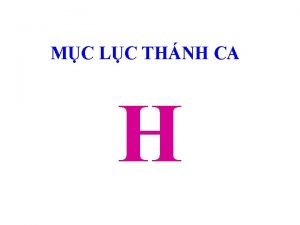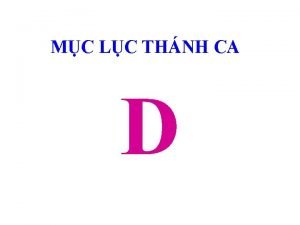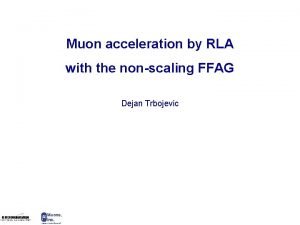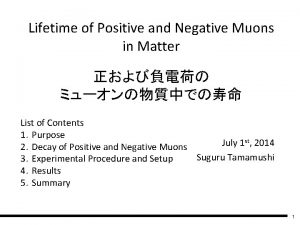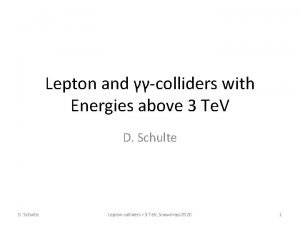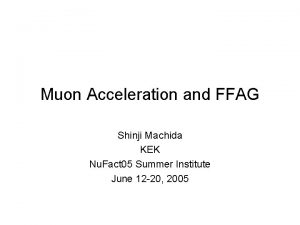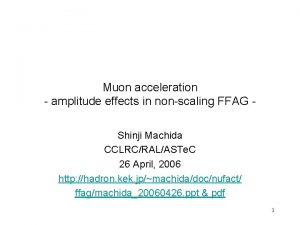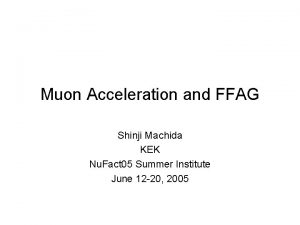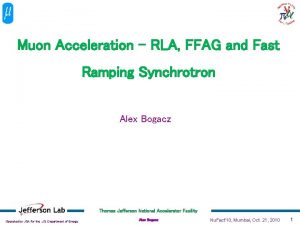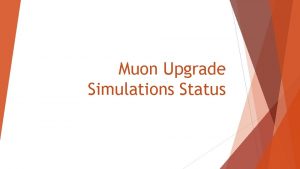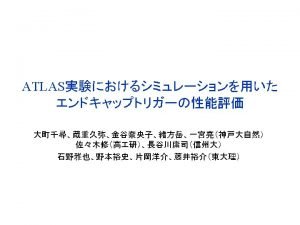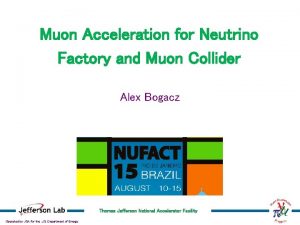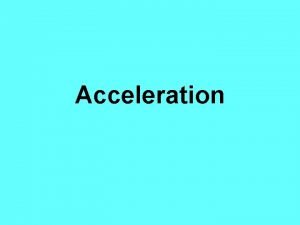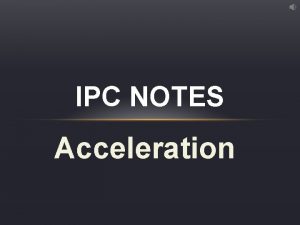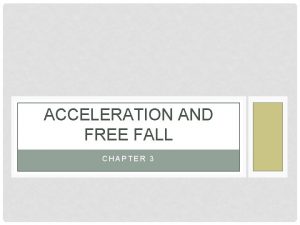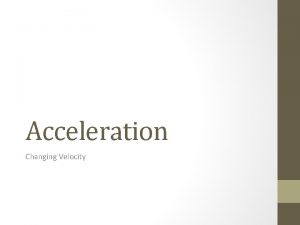Electron Model of LinearField FFAG for Muon Acceleration














- Slides: 14

Electron Model of Linear-Field FFAG for Muon Acceleration The Study 2 FFAGs for muon acceleration are NOT MURAstyle scaling FFAGs. § They are a new breed of accelerator, using linear elements, with characteristics well matched to the rapid acceleration of beams with large 6 D emittance. § They rely on novel and, as yet, untested beam-physics § They have been the subject of intensive study and simulation over the last 4 years at the FFAG workshops. § It is important to build a proof of principle model, and plans for that are the subject of this talk. § The purpose of the electron model is to demonstrate and investigate the novel features of a nonscaling FFAG at a small fraction of the cost of the multi-Ge. V muon machine. MUTAC Presentation, 25 April 2005, Shane Koscielniak, Triumf, Vancouver, BC, Canada.

Electron Model What does it look like? – like the KEK ATF (36 F 0 D 0 arc cells) but without its straight sections, and scaled down from 1. 5 Ge. V to 20 Me. V

Electron Model - novel accelerator physics Momentum Compaction The lattice will demonstrate the compaction of v. large range of momenta into remarkably narrow apertures. Under Livingood’s definition =(dp/p)/(d. L/L), at mid-energy for this machine. The FFAG operates at fixed magnetic field with a range of central momenta spanning 50% in p/p. This has two consequences. Gutter Acceleration The particle beam moves across the radial aperture, during acceleration, leading to changes in orbit shape which produce a quasi-parabolic time-of-flight variation. With fixed radio-frequency, this necessitates asynchronous acceleration within a rotation manifold outside the rf bucket.

Resonance Crossing • Machine has natural negative chromaticity, but central momenta span 50% in p/p. • This leads to crossing of many integer and ½-integer betatron resonances - this has not been done before. • The new FFAG pins operation on the hope that if crossing is fast enough, no damage is done. • October 2004: Based on tracking studies, Machida reported tolerances for alignment and quad strength rms errors of 0. 05 mm and 0. 1% - these are feasible to achieve • This successful demonstration of resonance crossing was a key milestone to proceeding with the design work. • But verification on a real machine is important for confidence and credibility. • The Po. P model will determine what level of random driving terms may be tolerated.

Electron Model - Specifications § 10 Me. V injection, 20 Me. V extraction § 42 identical cells. High periodicity produces self-cancellation of terms driving 1/3 -integer structure resonances. §Doublet lattice – combined function D and quad F (lowest cost) §Cell length 0. 42 m. No insertions (long straight sections) §Split betatron tunes h> v to reduce path-length variation §Magnets – peak field at pole tip less than 0. 2 T §Injection/Extraction scenario – feasible (15 cm) (0. 1 T) § 20 of 1. 3 GHz buncher-type cavities in alternate cells §Voltage 40 -120 k. V each (18 to 6 turns) §MA cavity or induction core for slow resonance crossing study

Lattice functions and example orbits versus momentum F D

News from 3 -7 April 2005 FFAG workshop at FNAL • Until now, lattice models have used sector bends. • Trbojevic points out that R-bends benefit from edge focusing, leading to an increase of vertical tune for high-momenta.

Insignificant effect on path-length variation 45 cell triplet lattice, 34 cm cell, 3 GHz RF. Electron models will be revised because of benefit to y. High-angle edge effects noticeable for rings with few cells, but will have v. little impact on 80 -100 cell muon rings.

Radiofrequency system Where possible adopt designs already existing at the host laboratory. Adopt 1. 3 GHz ELBE buncher cavity to be used at Daresbury 4 GLS 1. 3 GHz preferred over 3 GHz: reducing RF while magnet length is fixed, implies magnets become a smaller number of RF wavelengths. This implies smaller phase slip and more turns. Frequency variation of few 10 -4 to investigate 1 or 2 fixed points operation. Adopt TESLA-style linear RF distribution scheme to reduce number of waveguides R=1 M , Q=1. 4 104 20 cm straight for installation

Quadrupole Magnet Hardware – general principle – copying or modifying existing hardware is to be preferred over developing new designs. Fermilab Linac quad General requirements: • Gradient: 7 T/m • Slot length: 6 cm • Aperture: 40 mm wide, 25 mm high • Rep rate <1 Hz The 5 cm long upgrade Fermilab linac quadrupole has peak pole-tip field near 3. 5 k. G, and the bore is 5 cm. With a BPM installed the aperture is 3. 7 cm. This is ideal for the 3 cm orbit swing envisioned for the ring. Reverse bending is effected by offsetting of quad.

Combined function magnet Specifications §Permanent dipole component of 0. 15 T §Slot length: 10 cm §Magnetic length: 7 cm §Permanent quad component of ~4 T/m (steel shaping) §Quad trim coil provides +/- 20% §Magnet spacing: 5 cm §Aperture (good field): 50 mm wide, 25 mm high §Field uniformity 1% at pole tip §Space for internal BPM § 1 Hz operation or less Challenges §No cooling ØAspect ratio (gap to length) §No eddy current problems ØSqueeze so much into such a short slot ØEnd field

Dipole only field lines Magnet Concept (Vladimir Kashikhin, FNAL) n. Power Dipole plus quad field lines the dipole component with permanent magnets u. Compact u. No power issues u. Thermally stable PM material n. Power the quadrupole component with a (modified) Panofsky coil u. Compatible with rectangular aperture u. Relatively short ends

Electron Model – who will host? Daresbury Laboratory U. K. is very enthusiastic to host the electron model downstream of their 8 -35 Me. V Energy Recovery Linac Prototype (ERLP) of the 4 the Generation Light Source (4 GLS). Funding Sources? M£ 2. 5 funding was applied for under the Basic Technology Program of the Engineering and Physical Sciences Research Council on 11 th February. The program supports basic, high quality technology research. Principal investigators: Leeds University (School of Physics and Astronomy) & CCLRC ASTe. C Funding adequate for a small ring with no RF cavities; use energy-variability of linac to characterize dynamics. Future site of electron model

Funding - Continued M€ 2 applied for under the New and Emerging Science Technology (NEST) fund of the 6 th Framework Program of the European Union. Adventure projects criteria: (i) outside Thematic Priorities of FP 6 (ii) high novelty, ambitious, and has high-risk/high-impact character Projects implemented through Specific Targeted Research Projects. There is a 2 -Stage proposal. §Outline submission 13 th April 2005 §Invitation for full proposal mid-July 2005 §Signing of contracts April 2006 §Duration of project 2 years Principal investigator: Council for the Central Laboratory of the Research Councils (CCLRC), Accelerator Science and Technology Centre (ASTe. C). Potential Collaborators: BNL, CCLRC, CEA Saclay, CERN, FNAL, TRIUMF; universities of Grenoble, Kyoto, Lancaster, Leeds, Liverpool, Rostock (Germany), Uppsala (Sweden).
 Radial acceleration
Radial acceleration Relation between angular and linear quantities
Relation between angular and linear quantities Radial acceleration definition
Radial acceleration definition Linear acceleration vs tangential acceleration
Linear acceleration vs tangential acceleration Centripetal acceleration tangential acceleration
Centripetal acceleration tangential acceleration Acceleration of electron formula
Acceleration of electron formula Electron cloud model vs bohr model
Electron cloud model vs bohr model Muôốn tìm số chia
Muôốn tìm số chia đến muôn đời con cảm tạ
đến muôn đời con cảm tạ Nào cùng nhau ta lớn tiếng hát vui mừng
Nào cùng nhau ta lớn tiếng hát vui mừng Con xin dâng lên muôn lời suy tôn
Con xin dâng lên muôn lời suy tôn Muon collider
Muon collider Positive muon
Positive muon Muon collider
Muon collider Ca vang lên nào muôn dân hỡi
Ca vang lên nào muôn dân hỡi





